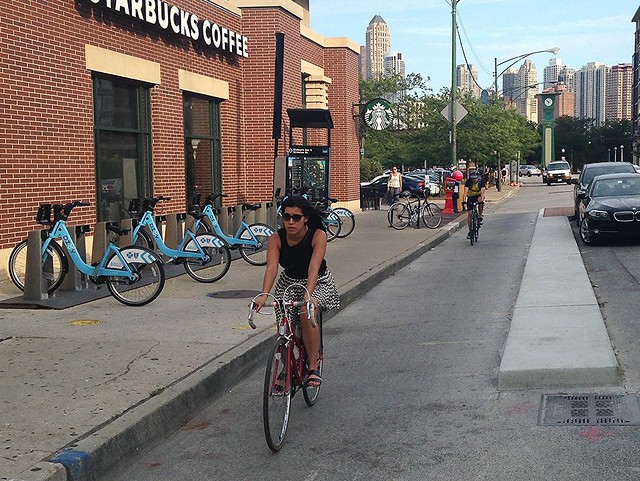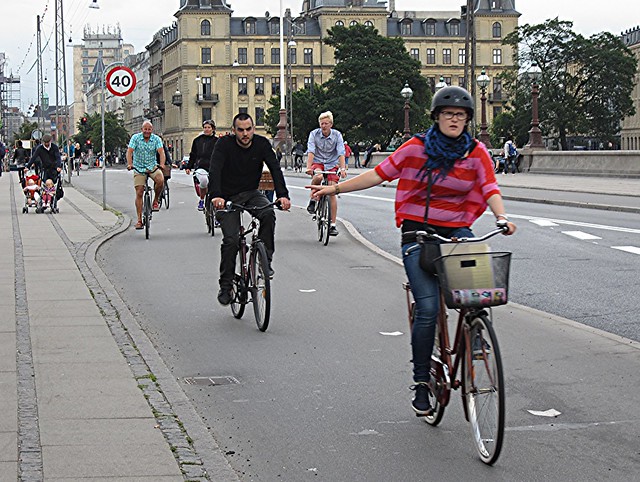CDOT’s 2015 Bikeways Report Highlights Last Year’s Many Innovative Projects
7:58 PM CDT on April 12, 2016

The Chicago Department of Transportation’s new report “2015 Bikeways – Year in Review” showcases the fact that the CDOT bike program got a heck of a lot of stuff done last year. It quantifies the significant progress that was made in 2015, the year the city debuted curb-protected bike lanes.
All told, CDOT installed about 20 miles of new buffered bike lanes and roughly three miles of protected lanes, as well as restriping some 19 miles of existing, faded lanes. The city has put in a total of 108 miles of bike lanes since Mayor Emanuel took office in 2011, including many miles of existing conventional lanes that were upgraded to buffered or protected lanes. Currently there are 87 miles of buffered lanes and 21.35 miles of protected lanes.
The city’s first curb-protected lanes went in on Sacramento, Milwaukee, Clybourn, Washington, and 31st Street. Concrete protection represents a big step forward towards creating a bike network that so-called “interested but concerned” types will feel comfortable using.
The new curb protection on 31st represents an upgrade from the old PBLs, which were chiefly separated from car traffic by plastic posts. “This project exemplifies the strategy of installing bike infrastructure quickly and then upgrading the project through future inprovements,” the report states.
CDOT also built the city’s first raised bike lanes on the north sidewalk of a short stretch of Roosevelt between State and the Grant Park skate park. Green “crosswalks for bikes” still need to be marked to shepherd cyclists through the cross streets.
While the Roosevelt bikeway is more of a demonstration project than a particularly useful route, hopefully the city will build a longer raised bikeway in the near future. It would be great to see Chicago pilot Copenhagen-style facilities, where the bike lane is located above the street level but below the sidewalk, which helps keep walkers out of the bike lane.
Last year CDOT made the Cortland, 18th Street, and South Halsted river bridges more bike-friendly by installing non-slip plates or concrete infill. 26 miles of bike network streets were repaved, providing a silky-smooth ride for cyclists.
The report highlights the downtown bike improvements that were made as part of the Loop Link bus rapid transit project. In addition to the eastbound Washington protected lane, located between the island bus stations and the curb, the city installed a two-way PBL on Clinton, including bike-specific stoplights.
The Clinton lane currently runs between Jackson and Fulton. This year, after the Union Station Transit Center is complete, the Clinton bike lane will be extend south to connect with the Harrison PBL, which connects with protected lanes on Canal.

This year a westbound protected bike lane will be constructed on Randolph, once construction at Block 37 is complete. The new PBL will replace the old westbound bike lane that used to be located two blocks south on Madison – that bike lane was eliminated when the Loop Link bus-only lane was put in on the street.
The report highlights the construction of new bike-friendly intersection treatments that were put in at Washington/Franklin and Washington/Dearborn as part of Loop Link, inspired by Dutch-style protected intersections. While the report refers to the new treatments as “protected intersections, Streetsblog’s Steven Vance has argued that they don’t actually fit that definition. Still it’s good to see CDOT trying something new here, and perhaps more robust intersection treatments will be piloted in the near future.
The report also touts the “green wave” signal timing that was implemented on Wells in River North with the goal of providing a steady sequence of green lights for cyclists proceeding at 12 mph. While the timing worked immediately after the change was made, the last few times Steven and I rode Wells, the green wave wasn’t working.
But these are fairly minor quibbles. CDOT deserves kudos getting a remarkable number of projects done last year, and the report doesn’t even mention the June 2015 opening of the Bloomingdale Trail. Here’s hoping 2016 will be even more eventful.
This post is made possible by a grant from the Illinois Bicycle Lawyers at Keating Law Offices, P.C., a Chicago, Illinois law firm committed to representing pedestrians and cyclists. The content is Streetsblog Chicago's own, and Keating Law Offices neither endorses the content nor exercises any editorial control.
In addition to editing Streetsblog Chicago, John writes about transportation and other topics for additional local publications. A Chicagoan since 1989, he enjoys exploring the city on foot, bike, bus, and 'L' train.
Read More:
Stay in touch
Sign up for our free newsletter
More from Streetsblog Chicago
Today’s Headlines for Thursday, April 26
The de-facto ban on riverwalk biking is back. What should we do about it?
In the short term, new signage is needed to designate legal areas for cycling on the path. In the long term CDOT should build the proposed Wacker Drive protected bike lane.





